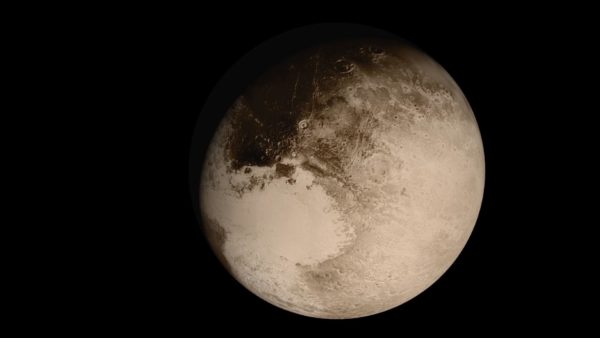
 A new study contends that erstwhile ninth planet Pluto may have an ocean more than 60 miles deep underneath its icy crust, a result which suggests that other large objects from the solar system’s outer regions may also harbour water in liquid form.
A new study contends that erstwhile ninth planet Pluto may have an ocean more than 60 miles deep underneath its icy crust, a result which suggests that other large objects from the solar system’s outer regions may also harbour water in liquid form.
Scientists continue to refine our picture of Pluto, that mysterious, frozen world which once languished in the pantheon of planets alongside Jupiter, Uranus and the rest, only later to be relegated to dwarf planet status and reframed as one of many Kuiper belt objects floating out in the far reaches.
But with 2015’s remarkable flyby of Pluto by NASA’s New Horizons spacecraft, not only did we laypeople here on Earth gain a much more detailed picture of Pluto in all its ghostly glory, astronomers, too, have profited immeasurably from a wealth of new data on the planet (sorry, dwarf planet).
The study led by Brandon Johnson, assistant professor of Earth, Environmental and Planetary Sciences at Brown University, begins with the question, what to make of Sputnik Planum, that large icy divot on Pluto’s surface? An icy plain on Pluto’s surface which makes up the western “lobe” of the heart-shaped image we see in visuals of Pluto, scientists believe Sputnik Planum to be have been caused by a large-scale asteroid impact which created a 900-km wide basin that subsequently filled in with nitrogen ice.
The intriguing thing about the formation is that it lies directly opposite (or underneath) Charon, Pluto’s closest moon which travels in tidal lock with Pluto, meaning that the same sides of each object always face each other. For that region of Pluto to have such a pull on Charon, astronomers say, Pluto’s mass must be unevenly distributed, with an inordinate amount directly below and always facing Charon – in space-speak, Sputnik Planum is a “positive mass anomaly.”
But, the mystery goes, how could it be that an impact crater like Sputnik Planum, basically a huge filled-in hole, be heavier than the rest of the planet? Using computer simulations of asteroid impacts on Pluto, researchers have determined that the extra mass below the surface of Sputnik Planum must be due to liquid water – and a lot of it. “This scenario requires a liquid ocean,” Johnson said. “What this tells us is that, if Sputnik Planum is indeed a positive mass anomaly —and it appears as though it is— this ocean layer of at least 100 kilometers has to be there.”
The scientists say that the result show the likelihood that other bodies in the solar system’s Kuiper Belt may contain subsurface liquid water as well. “It’s pretty amazing to me that you have this body so far out in the solar system that still may have liquid water,” says Johnson.
And now that New Horizons has completed its six-month- long visit with Pluto, the spacecraft will venture further into the Kuiper Belt to explore other objects in the solar system. New Horizons’ journey has been made possible by navigation provided by a team of researchers at the Canadian Astronomy Data Centre in Victoria, BC. The team used data from the Canada-France-Hawaii Telescope in Hawaii to generate a finely-detailed navigation star map for New Horizon.
Comment
One thought on “Pluto may have an ocean that is 60-miles deep, new study says”
Leave a Reply
You must be logged in to post a comment.



 Share
Share Tweet
Tweet Share
Share




My last stop!